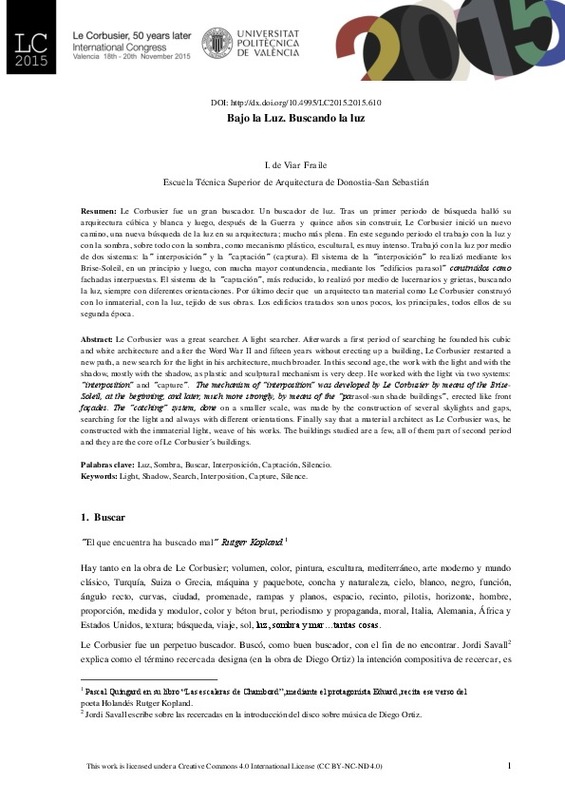JavaScript is disabled for your browser. Some features of this site may not work without it.
Buscar en RiuNet
Listar
Mi cuenta
Estadísticas
Ayuda RiuNet
Admin. UPV
Bajo la Luz. Buscando la luz
Mostrar el registro sencillo del ítem
Ficheros en el ítem
| dc.contributor.author | Viar Fraile, Iñigo
|
es_ES |
| dc.date.accessioned | 2017-09-11T06:31:39Z | |
| dc.date.available | 2017-09-11T06:31:39Z | |
| dc.date.issued | 2016-03-03 | |
| dc.identifier.isbn | 9788490483732 | |
| dc.identifier.uri | http://hdl.handle.net/10251/86891 | |
| dc.description.abstract | [EN] Le Corbusier was a great searcher. A light searcher. Afterwards a first period of searching he founded his cubic and white architecture and after the Word War II and fifteen years without erecting up a building, Le Corbusier restarted a new path, a new search for the light in his architecture, much broader. In this second age, the work with the light and with the shadow, mostly with the shadow, as plastic and sculptural mechanism is very deep. He worked with the light via two systems: “interposition” and “capture”. The mechanism of “interposition” was developed by Le Corbusier by means of the BriseSoleil, at the beginning, and later, much more strongly, by means of the “parasol-sun shade buildings”, erected like front façades. The “catching” system, done on a smaller scale, was made by the construction of several skylights and gaps, searching for the light and always with different orientations. Finally say that a material architect as Le Corbusier was, he constructed with the immaterial light, weave of his works. The buildings studied are a few, all of them part of second period and they are the core of Le Corbusier´s buildings. | es_ES |
| dc.description.abstract | [ES] Le Corbusier fue un gran buscador. Un buscador de luz. Tras un primer periodo de búsqueda halló su arquitectura cúbica y blanca y luego, después de la Guerra y quince años sin construir, Le Corbusier inició un nuevo camino, una nueva búsqueda de la luz en su arquitectura; mucho más plena. En este segundo periodo el trabajo con la luz y con la sombra, sobre todo con la sombra, como mecanismo plástico, escultural, es muy intenso. Trabajó con la luz por medio de dos sistemas: la” interposición” y la “captación” (captura). El sistema de la “interposición” lo realizó mediante los Brise-Soleil, en un principio y luego, con mucha mayor contundencia, mediante los “edificios parasol” construidos como fachadas interpuestas. El sistema de la “captación”, más reducido, lo realizó por medio de lucernarios y grietas, buscando la luz, siempre con diferentes orientaciones. Por último decir que un arquitecto tan material como Le Corbusier construyó con lo inmaterial, con la luz, tejido de sus obras. Los edificios tratados son unos pocos, los principales, todos ellos de su segunda época. | es_ES |
| dc.language | Español | es_ES |
| dc.publisher | Editorial Universitat Politècnica de València | es_ES |
| dc.relation.ispartof | LE CORBUSIER. 50 AÑOS DESPUÉS | es_ES |
| dc.rights | Reconocimiento - No comercial - Sin obra derivada (by-nc-nd) | es_ES |
| dc.subject | architecture | es_ES |
| dc.subject | le corbusier | es_ES |
| dc.subject | modern movement | es_ES |
| dc.title | Bajo la Luz. Buscando la luz | es_ES |
| dc.type | Capítulo de libro | es_ES |
| dc.type | Comunicación en congreso | es_ES |
| dc.identifier.doi | 10.4995/LC2015.2015.610 | |
| dc.rights.accessRights | Abierto | es_ES |
| dc.description.bibliographicCitation | Viar Fraile, I. (2016). Bajo la Luz. Buscando la luz. En LE CORBUSIER. 50 AÑOS DESPUÉS. Editorial Universitat Politècnica de València. 2275-2294. https://doi.org/10.4995/LC2015.2015.610 | es_ES |
| dc.description.accrualMethod | OCS | es_ES |
| dc.relation.conferencename | LC2015 - Le Corbusier, 50 years later | es_ES |
| dc.relation.conferencedate | November 18-20,2015 | es_ES |
| dc.relation.conferenceplace | Valencia, Spain | es_ES |
| dc.relation.publisherversion | http://ocs.editorial.upv.es/index.php/LC2015/LC2015/paper/view/610 | es_ES |
| dc.description.upvformatpinicio | 2275 | es_ES |
| dc.description.upvformatpfin | 2294 | es_ES |
| dc.type.version | info:eu-repo/semantics/publishedVersion | es_ES |
| dc.relation.pasarela | OCS\610 | es_ES |








